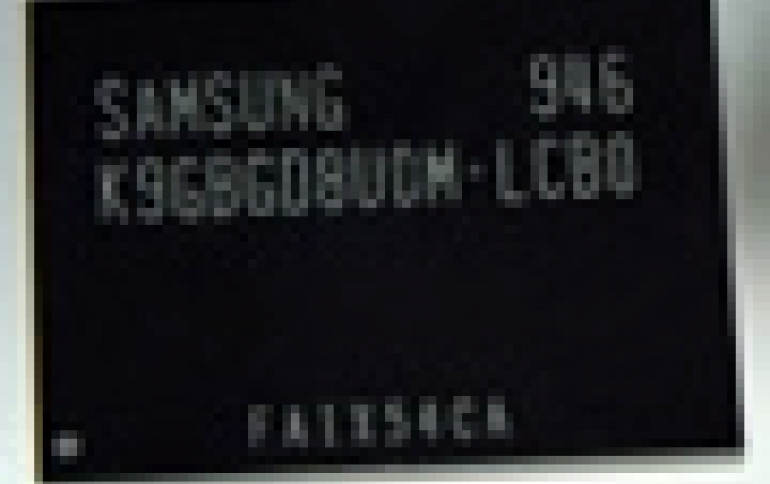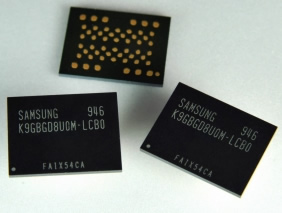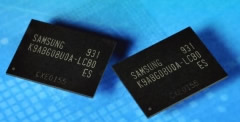
Samsung Starts Production of 30nm NAND Chips
Samsung, the world's largest maker of computer memory chips, said Tuesday it has started mass production of its latest and fastest NAND flash memory chips.
The company begun mass production its 30-nanometer (nm) class, 32 gigabit (Gb), multi-level-cell (MLC) NAND memory with an asynchronous DDR (double data rate) interface. The company said it began shipping initial production of its DDR NAND to major OEMs at the end of November.
In addition, Samsung has commenced the industry?s first volume production of 3-bit, multi-level-cell (MLC) NAND flash chips using 30-nanometer (nm)-class process technology at the end of November. The chips will be used in NAND flash modules accompanied by exclusive Samsung 3-bit NAND controllers to initially produce eight gigabyte (GB) micro Secure Digital (microSD) cards, the company said.
A NAND chip is a non-volatile computer memory that can be electrically erased and reprogrammed, primarily used in memory cards and drives for general storage and transfer of data between computers and other digital products.
30nm-class Asynchronous DDR NAND Flash
DDR NAND sharply raises the read performance of mobile devices requiring high-speeds and large amounts of storage space. Samsung?s new DDR MLC NAND chip, which reads at 133 megabits per second (Mbps), would replace single data rate (SDR) MLC NAND, which has an overall read performance of 40Mbps.
 "With the new DDR MLC NAND, double data rate transmission can be achieved without increasing power consumption, giving designers a lot more latitude in introducing diverse CE devices," said Soo-In Cho, executive vice president and general manager of the Memory Division at Samsung Electronics.
"With the new DDR MLC NAND, double data rate transmission can be achieved without increasing power consumption, giving designers a lot more latitude in introducing diverse CE devices," said Soo-In Cho, executive vice president and general manager of the Memory Division at Samsung Electronics.
Samsung?s new asynchronous DDR MLC NAND can be used in SSDs for PCs, premium SD memory cards for smartphones, and in Samsung?s proprietary moviNAND memory. In addition, the new memory can be used to personal media players (PMPs), MP3 players and car navigation systems (CNS).
Production of the Samsung 30nm-class DDR MLC NAND comes just eight months after the company announced availability of its 30nm-class 32Gb MLC NAND.
Use of 30nm-class DDR NAND enables premium memory cards to register 60Mbps read speeds, at least a 300 percent performance gain compared to SDR NAND-based memory cards with an average 17Mbps read speed.
Mass production of asynchronous DDR MLC NAND, like the introduction of 30nm-class 3-bit MLC NAND, is expected to substantially raise the portion of NAND flash production devoted to high density consumer electronics (32GB and above) to accommodate increased video sharing.
According to market research firm Gartner Dataquest, the global NAND flash memory market is forecast to be worth US$13.8 billion in 2009 and reach US$23.6 billion by 2012.
30nm, 3-bit Multi-Level-Cell NAND Chips
Samsung also started volume production of 3-bit, multi-level-cell (MLC) NAND flash chips using 30-nanometer (nm)-class process technology at the end of November.
 "Introducing cost-efficient, 30nm-class 3-bit technology widens our NAND memory solution base to make NAND even more enticing for increasingly diverse market applications," said Soo-In Cho, executive vice president and general manager of the Memory Division at Samsung Electronics. "Our 3-bit NAND memory will support the development of more cost-competitive, high-density consumer electronics storage solutions," he added.
"Introducing cost-efficient, 30nm-class 3-bit technology widens our NAND memory solution base to make NAND even more enticing for increasingly diverse market applications," said Soo-In Cho, executive vice president and general manager of the Memory Division at Samsung Electronics. "Our 3-bit NAND memory will support the development of more cost-competitive, high-density consumer electronics storage solutions," he added.
Three-bit MLC NAND increases the efficiency of NAND data storage by 50 percent over today?s pervasive 2-bit MLC NAND chips. Samsung?s new 30nm-class 3-bit MLC NAND will provide consumers with effective NAND-based storage that can be applied to USB flash drives in addition to a range of micro SD cards.
In 2005, Samsung introduced the first 50nm-class, 16Gb MLC NAND memory device. Mass production of 30nm 3-bit NAND is expected to significantly raise the portion of NAND flash memory production devoted to high densities (32Gb and above), designed to accommodate increased video usage.
In addition, Samsung has commenced the industry?s first volume production of 3-bit, multi-level-cell (MLC) NAND flash chips using 30-nanometer (nm)-class process technology at the end of November. The chips will be used in NAND flash modules accompanied by exclusive Samsung 3-bit NAND controllers to initially produce eight gigabyte (GB) micro Secure Digital (microSD) cards, the company said.
A NAND chip is a non-volatile computer memory that can be electrically erased and reprogrammed, primarily used in memory cards and drives for general storage and transfer of data between computers and other digital products.
30nm-class Asynchronous DDR NAND Flash
DDR NAND sharply raises the read performance of mobile devices requiring high-speeds and large amounts of storage space. Samsung?s new DDR MLC NAND chip, which reads at 133 megabits per second (Mbps), would replace single data rate (SDR) MLC NAND, which has an overall read performance of 40Mbps.
 "With the new DDR MLC NAND, double data rate transmission can be achieved without increasing power consumption, giving designers a lot more latitude in introducing diverse CE devices," said Soo-In Cho, executive vice president and general manager of the Memory Division at Samsung Electronics.
"With the new DDR MLC NAND, double data rate transmission can be achieved without increasing power consumption, giving designers a lot more latitude in introducing diverse CE devices," said Soo-In Cho, executive vice president and general manager of the Memory Division at Samsung Electronics.
Samsung?s new asynchronous DDR MLC NAND can be used in SSDs for PCs, premium SD memory cards for smartphones, and in Samsung?s proprietary moviNAND memory. In addition, the new memory can be used to personal media players (PMPs), MP3 players and car navigation systems (CNS).
Production of the Samsung 30nm-class DDR MLC NAND comes just eight months after the company announced availability of its 30nm-class 32Gb MLC NAND.
Use of 30nm-class DDR NAND enables premium memory cards to register 60Mbps read speeds, at least a 300 percent performance gain compared to SDR NAND-based memory cards with an average 17Mbps read speed.
Mass production of asynchronous DDR MLC NAND, like the introduction of 30nm-class 3-bit MLC NAND, is expected to substantially raise the portion of NAND flash production devoted to high density consumer electronics (32GB and above) to accommodate increased video sharing.
According to market research firm Gartner Dataquest, the global NAND flash memory market is forecast to be worth US$13.8 billion in 2009 and reach US$23.6 billion by 2012.
30nm, 3-bit Multi-Level-Cell NAND Chips
Samsung also started volume production of 3-bit, multi-level-cell (MLC) NAND flash chips using 30-nanometer (nm)-class process technology at the end of November.
 "Introducing cost-efficient, 30nm-class 3-bit technology widens our NAND memory solution base to make NAND even more enticing for increasingly diverse market applications," said Soo-In Cho, executive vice president and general manager of the Memory Division at Samsung Electronics. "Our 3-bit NAND memory will support the development of more cost-competitive, high-density consumer electronics storage solutions," he added.
"Introducing cost-efficient, 30nm-class 3-bit technology widens our NAND memory solution base to make NAND even more enticing for increasingly diverse market applications," said Soo-In Cho, executive vice president and general manager of the Memory Division at Samsung Electronics. "Our 3-bit NAND memory will support the development of more cost-competitive, high-density consumer electronics storage solutions," he added.
Three-bit MLC NAND increases the efficiency of NAND data storage by 50 percent over today?s pervasive 2-bit MLC NAND chips. Samsung?s new 30nm-class 3-bit MLC NAND will provide consumers with effective NAND-based storage that can be applied to USB flash drives in addition to a range of micro SD cards.
In 2005, Samsung introduced the first 50nm-class, 16Gb MLC NAND memory device. Mass production of 30nm 3-bit NAND is expected to significantly raise the portion of NAND flash memory production devoted to high densities (32Gb and above), designed to accommodate increased video usage.





















